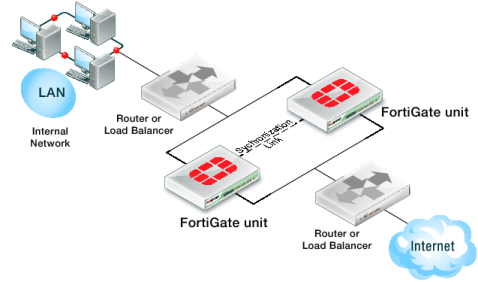FortiGate Session Life Support Protocol (FGSP)
You can use the config system session-sync command to configure the FortiGate Session Life Support Protocol (FGSP) (previously called TCP session synchronization or standalone session synchronization) between two FortiGate units. The two FortiGate units must be the same model. The FGSP synchronizes both IPv4 and IPv6 TCP, UDP, ICMP, expectation, and NAT sessions. You can use this feature with external routers or load balancers configured to distribute or load balance sessions between two peer FortiGate units. If one of the peers fails, session failover occurs and active sessions fail over to the peer that is still operating. This failover occurs without any loss of data. As well, the external routers or load balancers will detect the failover and re-distribute all sessions to the peer that is still operating.
| In previous versions of FortiOS the FGSP was called TCP session synchronization or standalone session synchronization. However, the FGSP has been expanded to include configuration synchronization and session synchronization of connectionless sessions, expectation sessions, and NAT sessions. |
| You cannot configure FGSP HA when FGCP HA is enabled. However FGSP HA is compatible with VRRP. |
| FGSP or standalone session synchronization is not supported if the FortiGate units are running different firmware versions. |
The FGSP can be used instead of FGCP HA to provide session synchronization between two peer FortiGate units. If the external load balancers direct all sessions to one peer the affect is similar to active-passive FGCP HA. If external load balancers or routers load balance traffic to both peers, the effect is similar to active-active FGCP HA. The load balancers should be configured so that all of the packets for any given session are processed by the same peer. This includes return packets.
By default, FGSP synchronizes all IPv4 and IPv6 TCP sessions and also synchronizes the configuration of the FortiGate units.
You can optionally enable session pickup to synchronize connectionless (UDP and ICMP) sessions, expectation sessions, and NAT sessions. If you do not enable session pickup, the FGSP does not share session tables for the particular session type and sessions do not resume after a failover. All sessions that are interrupted by the failover and must be re-established at the application level. Many protocols can successfully restart sessions with little, or no, loss of data. Others may not recover easily. Enable session pickup for sessions that may be difficult to reestablish. Since session pickup requires FortiGate resources, only enable this feature for sessions that you need to have synchronized.
You can also optionally add filters to control which sessions are synchronized. You can add filters to only synchronize packets from specified source and destination addresses, specified source and destination interfaces, and specified services.
Load balancing and session failover is done by external routers or load balancers instead of by the FGSP. The FortiGate units just perform session synchronization to support session failover.


